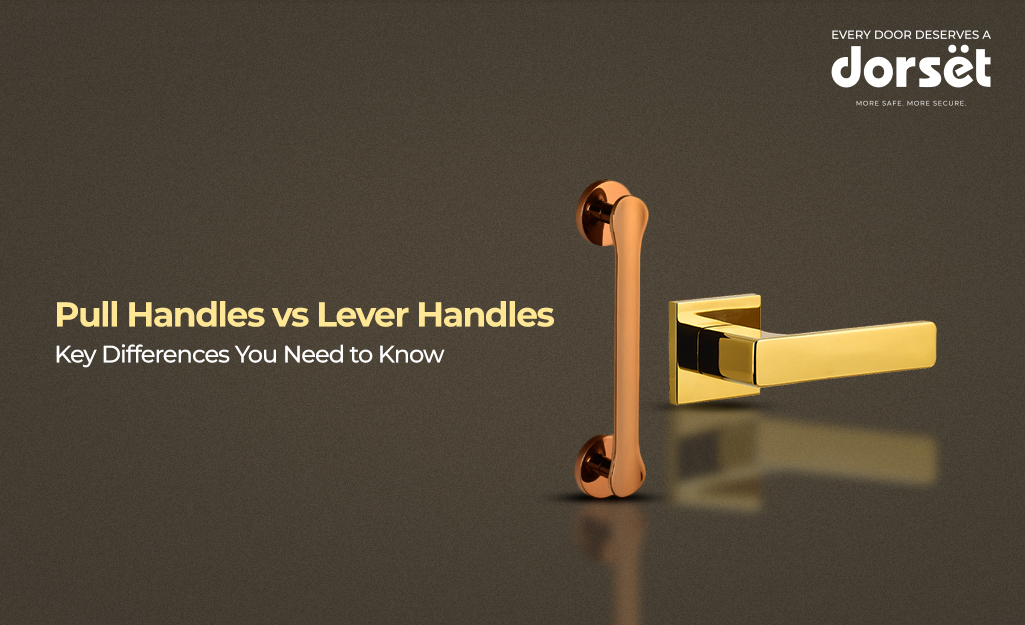
There are two types of door handles you’ll see everywhere: pull handles and lever handles. Both open doors, but they do it in completely different ways and suit different kinds of spaces. Often the choice between the two isn't random. It is based on function, context, and design philosophy.
So which type of handle should you choose for your door?
What Defines Each Handle Type
Pull handles are fixed grips mounted vertically or horizontally. They don’t move. You use the force to push or pull. Available as bars, tubes, or sculptural pieces, they’re versatile and purely manual.
Lever handles, on the other hand, pivot to operate a latch. Pressing down rotates the spindle, retracts the latch, and opens the door. Instead of just gripping, you’re activating a mechanism, which changes the experience completely.
Sometimes, you’ll even see both on the same door. A pull handle outside for entry, paired with a lever handle inside for easy exit.
Operational Mechanics
Lever handles connect directly to the latch system. Pressing down retracts the bolt, making the door swing open. The installation of this door handle is very precise and requires alignment with spindles and latch bodies. But once fitted, they’re effortless to use.
Pull handles are mechanically simpler. They attach with bolts or screws and don’t interact with locks. This makes them suitable for sliding, pivot, and swing doors alike. Their independence from latch systems adds flexibility, especially in settings like an office.
Our Mohana Premium Pull Handle and Forte Premium Pull Handle highlight this adaptability designed to fit seamlessly across applications while looking beautiful on your doors.
Where Each Type Excels
Lever handles thrive indoors. They’re perfect for bedrooms, bathrooms, and offices where you need quick, one-handed operation. Their design also makes them essential for accessibility easy to use with minimal grip, even by pressing with an elbow or forearm.
Pull handles shine in busy areas. They’re common in shopping malls, offices, and hotels where easy use and durability are key, and there isn’t much need for the door to latch every time. Glass doors especially benefit from them.
They also excel with heavy doors. Solid wood, metal, or fire doors need leverage, and pull handles provide the strength lever handles can’t match. Our Arch Premium Pull Handle and Curve Premium Pull Handle give you this strength while elevating design.
Design Language and Aesthetics
Lever handles suit residential comfort. Their horizontal form feels natural to the hand and complements intimate, human-scale design. Collections like Dorset’s Abitare and Farretto show how levers enhance warmth and familiarity in homes.
Pull handles, by contrast, command attention. Their vertical lines create rhythm and presence, often doubling as architectural statements. The Ebony Premium Pull Handle brings striking geometry to glass or metal doors.
Material choices amplify these qualities. Brass or gold lever handles, such as those in our NU Plus Collection, evoke luxury, while stainless steel levers lean modern. The same finishes on pull handles create bolder impressions simply due to their size and prominence.
The Quick Comparison
|
Aspect
|
Pull Handles
|
Lever Handles
|
|
Mechanism
|
Static grip, no moving parts
|
Pivoting lever operates latch mechanism
|
|
Installation
|
Simple mounting with bolts
|
Requires spindle alignment and latch coordination
|
|
Best Applications
|
Heavy doors, glass doors, commercial entrances
|
Interior doors, residential applications, accessible design
|
|
Operation
|
Requires grip strength and pulling force
|
Press down with minimal effort
|
|
Maintenance
|
Virtually maintenance-free
|
Requires periodic lubrication and adjustments
|
|
Accessibility
|
Can be challenging for limited mobility
|
Excellent for universal design
|
|
Visual Impact
|
Bold architectural statement
|
Subtle, human-scaled presence
|
|
Durability
|
Extremely durable with proper mounting
|
Moving parts subject to wear
|
|
Initial Cost
|
Generally higher
|
More economical for basic models
|
Making Your Choice
Your decision depends on context.
- For homes and interiors: lever handles make daily life easier, especially for children, elderly, or anyone with limited mobility. Collections like Farretto or Abitare fit naturally.
- For commercial entrances: pull handles create impact, durability, and clarity. Models like Mohana or Curve deliver presence and strength.
- For accessibility: lever handles often meet building codes and are the more inclusive choice.
- For fire or security doors: pull handles often pair with panic bars or electromagnetic locks, depending on regulations.
Think about users: elderly residents benefit from levers, children may find pull handles easier, and busy spaces demand pull-handle resilience.
Beyond Binary Choices
You’re not locked into one choice. Many projects mix both pull handles for main entrances, lever handles for private interiors. This variety helps in use and makes sure each space functions best.
Sometimes, both kinds of door handles appear on the same door. A pull handle outside provides clear entry, while a lever inside gives an effortless exit. Far from indecision, this combination reflects thoughtful design.
Ultimately, hardware is about experience. Pull handles create moments of tactile engagement, while lever handles prioritise seamless function. Neither is universally superior. They simply excel in different contexts. Choosing your door handle wisely ensures your spaces feel as good as they look.
Check out the Dorset door handle collection today!